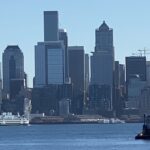Seattle 2021: West Seattle, San Juan and Walla Walla
My daughter moved to Seattle in the Fall of 2009 to attend the University of Washington. She has lived there since, went on to law school and is now a practicing attorney and a homeowner. In those twelve years, within the city, she moved from the University District to Capitol Hill and now lives in West Seattle. I have visited her many times, but usually for just a few days. Over the years, I have been to most of the tourist destinations such as Pike Place Market, Space Needle, and several museums. As my daughter’s wedding plans are taking shape, and talk of grandchildren has begun, the chances of spending more time in Seattle have increased. I decided to visit for a month to assess how I would take to staying for weeks or months. With the region’s reputation for constant rain, I chose the summer for my visit when it is supposedly less wet. The weather complied–aside from a couple of mornings of mist and light drizzle, which burned off by the afternoon, it was sunny and warm, even hot on a few days.

Downtown Seattle
West Seattle is a peninsula surrounded by Puget Sound. It is connected to downtown Seattle to the East, with its cluster of high-rise buildings, by a ferry service, that I took several times. Alki Beach to the West, has a lighthouse for a landmark and the Olympic mountain range in the background. The first European settlers landed here in 1851, on a cold misty morning, planning to build a city until they discovered a better port near what is now Pioneer Square, an area I spent time in, too. The water in the Sound is too cold to swim without a wetsuit, but good for Kayaking, and the beach is used for yoga and other exercises.

Alki Beach
I took a long walk down to the lighthouse, passing the kinds of shops and restaurants found in beach resorts. It was not imposing and, in any case, was cordoned off by the Coast Guard. Two large parks, Lincoln Park and Schmitz Preserve, provide open spaces and greenery for people and many pet dogs to amble. Lincoln Park hugs the Sound South from Alki Point. It has open grass fields between clumps of trees and bushes and is large enough for long walks. It also has barbecue facilities and a boundary road hugging the shore for walkers, joggers, and fisherman to throw their lines into the Sound. Schmitz Preserve, in the center of the peninsula, is a 35 acre rainforest with dense vegetation, walking paths and a creek flowing though it. It was my favorite hike. I was usually alone, hearing just the sound of the water and birds. Occasionally I saw children playing by the creek and a few adults taking brisk walks.
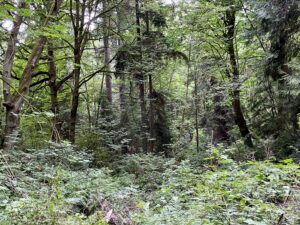
Schmitz Preserve
I rented a comfortable apartment, conveniently located about a half-mile from my daughter’s house, just off California Ave SW, the main road connecting neighborhoods known as Admiral and Alaska Junctions. It was adjacent to a gas station with a store, but that did not cause any disturbance or provide convenience. Pedestrian paths on both sides of the avenue are lined with trees that provide shade, and the streets to East and West have modest residences fronted by small yards with a garage to the side. The area has several public and private schools. Except for some modernized apartment buildings and houses, most structures were dated, gave the feeling of an established, but changing neighborhood. This was confirmed at a Block party held on my daughter’s yard as the people who dropped by were a mix of old and young, and recent immigrants as well.
California Avenue, for the mile between the junctions, has some shops on the ground floor of narrow, three or four story apartment buildings and some remaining small houses. These were hair and nail salons, wellness offerings such as massages of various kinds, and some medical, realtors’ and lawyers’ offices, a bank and a church. I had a few reflexology massages to ease the stress on my feet from miles of daily walking. The masseurs were a Chinese couple who did not speak English. I had to communicate with them through their call center. Having noticed lines outside OH’s Bahn Mi Sandwiches at lunch times, I tried one made with Tofu, but it was unexciting. Perhaps the meat versions are better. The Rose wine at Welcome Road Winery, within a block of my apartment, was not bad, and the conversation with the server, a retired fireman from the San Francisco Bay Area, was lively, contrasting life there with Seattle.
Several grocery stores serve both junctions. I used the Met Market for bread and fabulous chocolate chip cookies, Safeway for wine, Whole Foods for groceries and occasionally the PCC Community Market, the store nearest my apartment. A sizable Farmers Market was held on Sundays at Alaska Junction. With the varied geography of Washington State and its long coastline, produce, meat and seafood are fresh and abundant.
Neighborhood restaurants offered a full range of ethnic cuisines, but none of remarkable quality. I returned to couple of them several times. Seattle Fish Company is a fishmonger with a small, unpretentious restaurant. Everything it served or sold was fresh and well prepared. In the restaurant, I had several types of chowder and a variety of fried fish. I liked best the crab bisque and the fried halibut with crispy chips. Their inexpensive Chardonnay and dry Riesling accompanied the food well. The crab and halibut cakes I bought and were cooked in olive oil at my daughter’s house were lightly seasoned to enhance their natural flavor. Bakery Nouveau always had a line outside, especially on weekend mornings. I liked their croissants, almost like those in France, crisp, flakey layers but not quite down to the core. And their quiches were silky smooth, made with creamy, mild cheeses and mushrooms or spinach. Generally, evening meals were at my daughter’s house accompanied by her boyfriend and two dogs—Finn, a Golden, and Nova, an Alsatian. After July 23, the Olympics on TV were part of the dinner conversation.
Several wineries had tasting rooms nearby. Among them I liked Darby best. One evening, my daughter and I tasted a flight of four wines, which we enjoyed although it was difficult to retain the distinct flavor of each of them. Later, the server gave us some Provencal style Rose as a bonus, which I remembered as a refreshing blend of melon and strawberry with a light finish. On another evening, there alone, I was given a generous helping of Flipside, a blend of Grenache, Syrah and Mourvedre, a Rhone style wine that was polished, with hints of raisins and black tea. I chatted with the winemaker, Darby English who had dropped by, and got his suggestions for wineries to visit in the Walla Walla river valley. Aside from winery outlets, I stuck to light Washington State wines such as Pinot Gris, dry Riesling, and Rose, all flavorful and inexpensive.
Despite the many grape growing areas around Seattle, residents prefer beer. I learned that 75 percent of the hops grown in US are from the Yakima area, not far from Seattle, and the US is second to Germany by a hair in hop production. I enjoy an occasional Imperial IPA, bitter beer with high alcohol content. At the Elliot Bay Brewery, I had an Organic Demolition Ale (7.2% ABV and 90 IBU): ABV is alcohol by volume and IBU, which scales to 100, is the international bitterness unit, something I learned during this visit. It was bitter indeed, wholesome and strong, almost a meal on its own. Many regulars came with huge, half gallon or larger steins, to fill and take home, enjoying some kind of club and volume discount. In contrast, to bitter beer, Prost Bar served German lagers that were light and elegant.
The ferry from West Seattle docked near the end of Yesler Way that led to the Pioneer Square area near downtown. This was the site of the original settlement, favored over Alki beach. The term “skid row” originated here because timber was skid down to the sawmill over logs laid crosswise. It was the city’s first commercial centre and built with wood. A fire in 1889 destroyed it. As the original settlement was constructed on tidelands that flooded frequently, it was rebuilt a story higher. Walking through the several remaining underground passageways was the subject an Underground Tour, full of humorous anecdotes about the personalities and corruption of that era. Apparently, the madam of a notorious whorehouse financed the rebuilding.

Pioneer Square
The modern Pioneer Square area is somewhat funky, has many art galleries, bars, cafes and restaurants and a colony of homeless tents. I visited the Axis gallery, a huge space that presented the bold, colorful work of Kerry Baldwin, an abstract expressionist painter, and the Kucera Gallery, also a nice space, but its main exhibit of Jeffrey Simmons’ paintings of patterns was not appealing, though I rather liked an abstract piece by Whiting Tennis. I ended my walk at a small urban garden at the site of the first UPS office, where a man-made waterfall flowed over large granite stones enclosed in lush greenery, with a few tables and chairs for people sit and enjoy the surroundings.

Kerry Baldwin
Seattle’s two major sports stadia are close by. I attended a soccer game at Lumen Stadium. The local Seattle Sounders played against Kansas City Sporting. Although the Sounders had a good record, they spent most their ball possession time passing backwards toward their goalie, hardly the way to score goals. They were soundly defeated 3-1. The game was surprisingly well attended and the crowd was almost as raucous and noisy as in Europe, no doubt helped by the alcohol served by concession stands that circle the stadium.
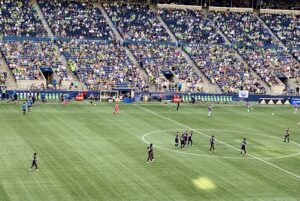
Sounders at Lumen Stadium
Adjoining Pioneer Square to the south and east is the International District, mostly Asian, and vaguely divided by its geography. The buildings, gardens and restaurants immediately to the East have Japanese names. I had a great lunch at Fuji Sushi with old friends from San Francisco that I reconnected with after decades. It had the best Bento Box lunch (salad, rice, California roll, vegetable and shrimp tempura, mixed poke and ginger tofu) in ages. The Kobe Terrace Park was nearby, with Mt. Fuji trees and a stone lantern presented by Kobe, the sister city to Seattle. Across the street, the Panama Hotel, not Japanese sounding, had a small, neat tea-room in the reception area. Glass covering a part of the floor showed belongings left behind when the Japanese were hurriedly taken into internment during WW II.

Chinese Restaurants
A little to the south, Chinese restaurants are cheek by jowl. My attempts to eat at a renowned one failed because of the long line blamed on the shortage of staff, but I did find another to have a simple lunch. I also failed to see the Wing Luke Museum because of Covid restrictions on timing and tours. Coming down towards the shore, I stopped at Uwajimaya Village store, the largest supermarket of Asian food I have ever seen. Had I not already eaten, I would have feasted on the attractive offerings from all over the continent. Not far from this sumptuary were homeless encampments near King Street and Union stations, jarring me back to reality. On another visit, I walked further up to the East, where Vietnamese restaurants and stores dominate. I had a nice meal at the Tamarind Tree (salad roll with lemon grass tofu and fried shrimp with sweet potatoes) and walked through a well-stocked general store filled with goods and narrow passages for people to browse and buy.
I couldn’t resist one visit to the tourist area. I went to the Seattle Art Museum, tempted by a small, but interesting exhibit of Monet’s work from the Normandy village of Etretat, paintings of ships and cliffs. He did many versions of each scene, a quest for perfection that he carried over to his later work on water lilies. Aside from the show, the museum has an eclectic collection of paintings and art objects from all over the world, a good introduction to what the world offers. After the visit, I walked down to Pike Place Market, the epicenter of tourism, and lined up to lunch on the famous Beechers Mac and Cheese with Smoked Salmon.

Monet
I made several trips with my daughter and future son-in-law in the city, to the outskirts of Seattle and to Bellingham, a more distant university town, in the hunt for a wedding venue for them for September 2022. I rather liked the Washington Athletic Club, a traditional venue downtown, but they settled on a golf club with good outdoor and indoor facilities in case it rains, always a risk in Seattle.

Mt. Rainier
Other day trips were to scenic destinations and a longer trip to a valley known for its wine. Crystal Mountain is a ski resort at an altitude of about 2500 ft, a couple of hours drive in the Cascade range. Because a wedding was planned for about the time we arrived, there were more people around than usual, but the crowd thinned when we reached the top of the mountain on a long gondola ride. A steep valley dropped on the other side and rose to the majestic snowcapped Mount Rainier, 14,400 ft high. Further back and to the left was the Mount Saint Helens volcano with its missing cone, blown away when it erupted a few decades ago. The number of visitors of Indian origin was striking. Were they hankering for a view of the Himalayas? On the way back we stopped at Pie Goddess in Enumclaw, owned by an Indian family, to pick up slices of delicious pie, Pecan for me. Immigrants from India have a noticeable presence in Seattle, especially in its dominant information technology companies, but elsewhere too, such as Pramila Jayapal, who represents West Seattle in Congress.

Mt. St. Helens
We drove for two-hours north of Seattle to Anacortes to take the ferry for San Juan Island. It took about an hour from there to reach San Juan, plying along the shores of many other islands with snowcapped Mt. Baker, another volcano in the Cascades range, as a backdrop. After alighting, we made a dash for a restaurant to beat the other passengers who would also be looking for lunch. The Cask and Schooner looked like the British country pub that it was modeled after, wooded walls and bar, dark inside despite the high windows. As San Juan Island is a tourist destination, I did not expect haut cuisine, but I could actually taste Crab in my Risotto and the portion was large enough for two meals. We walked around the island, stopped at a small used bookstore with dense piles of books in small, claustrophobic low-roofed rooms, and an art gallery whose garrulous artist-owner held our attention for half an hour. Our final stop was at the island’s brewery where the beer and the food were unexceptional but expensive. The ferry ride back had a better view of Mt. Baker.
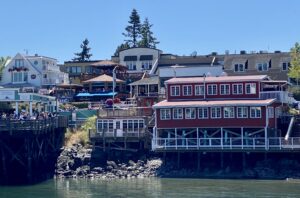
San Juan Island Marina
One Sunday, we drove down to Olympia, the capital of Washington State, to lunch with friends who moved to Seattle from San Francisco decades ago, and recently to Olympia to be near their daughter’s growing family. We had a pleasant meal at an Italian restaurant by an artificial lake near the Capital building. Their daughter, son-in-law, my daughter and her fiancé, all lawyers, exchanged notes about their work and profession, while us parents chipped in now and again. On another Sunday, we lunched with my daughter and her fiancé’s former law professor and his wife, who is also a lawyer. As the professor’s specialty is Anti-Trust, we discussed the recent appointment of Lina Khan as Chair of the Federal Trade Commission. Their house, on a bluff in the Magnolia suburb of Seattle, had magnificent views of the Sound and Olympic Range from the deck. Indeed, gorgeous views of the water and mountains are available almost everywhere in Seattle.
For our visit to Walla Walla, we drove for about five hours over the pine forested Cascades in rain and mist down to a sunny wide valley, sometimes green with irrigated agriculture, but mostly a desert like vista similar to inland California, with brown hills on both sides, some crested by wind farms. Further down we crisscrossed the wide Columbia River and briefly the Yakima River as well. Together with the Walla Walla river valley, these are the main wine producing areas of Washington State.

Walla Walla
We arrived in the town of Walla Walla late on a sunny afternoon. Our Airbnb looked unfinished on the outside causing concern, but it was a comfortable apartment and situated within a couple of blocks of the town center, as we soon discovered. The premier section of Main Street had some old buildings dating back to the 1870s, but most of it looked like St. Helena in Napa, catering entirely to tourists. Restaurants and wine tasting rooms dominated and also shops selling tourist kitsch. A square blocked to traffic had a band playing Rock music that attracted many listeners and a few dancers too. As the evening progressed, another band played soulful jazz.

Valdemar Estate Winery
The wineries we visited in the next couple of days had good wines, mostly blends of Grenache, Mourvedre and Syrah, but the unblended Syrahs were the best. At Sleight of Hand, the Levitation Syrah, dark and smoky, and Sorceress Grenache, lighter with hints of tobacco, were outstanding; and at Rotie, the Homage, also dark and full bodied and mostly Mourvedre, was in that class as well. I barely resisted the temptation of signing up for their wine clubs. That said, the wines at Saviah and Valdemar Estate, were pretty good too. At Valdemar, owned by an established Spanish winery, we enjoyed a tapas lunch served on the deck of its ultra modern building with a wide vista behind us. Not much of the surrounding land was planted to grapes, also noticeable at other wineries. Larger spaces were allocated to other agriculture, unlike Napa, where the countryside is covered in vines.
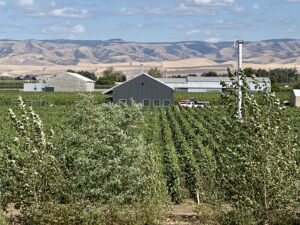
Rotie Cellars Winery
On one morning, by chance I walked through the Whitman College campus, an old liberal arts college. Founded as a seminary by a territorial legislative charter in 1859, the school became a four-year degree-granting institution in 1882 and abandoned its religious affiliation in 1907. The large campus comprised mostly of well-kept traditional style redbrick buildings, mowed lawns with flowerbeds and statues placed here and there. A few aged people were shuffling in the tennis courts as I passed by reminding me that I would probably look as inept too. Nearby a plaque recorded a treaty in 1855 when the local Indian tribes allowed European immigrants to settle in the area.
We took a different route on the way back, began by driving along the Yakima River, green along its banks and bordered by brown hills on both sides. Aside from grapes, we passed fields planted to hops, wheat, and beans, and apple and peach orchards. When we climbed the Cascades nearer Seattle, it remained dry and sunny, made the drive back home less stressful.
As my daughter’s relationship is settling, progressing from boyfriend to husband next year, and already two dogs and possibly expanding with grandchildren, summer months in Seattle are in my future. The city has much left to explore, its music, theater, art, food and wine; and the State’s topography offers great hiking trails, and several river valleys that produce good wine, the second most in the country after California.
